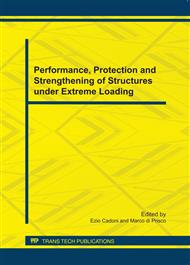p.332
p.338
p.344
p.350
p.356
p.362
p.368
p.374
p.380
An Experimental Research on the Fire Behavior of Composite Truss Structure Used at World Trade Center
Abstract:
Composite Truss has several benefits such as rapid construction and low span/depth ratio and is a competitive structure shape of span length having 12m to 18m. However, developed countries become aware that additional research is needed to analyze fire behavior for tall buildings after the September 11th attacks. This research is conducted to carry the experimental study of fire behavior of composite truss which was used in the World Trade Center. This study examined thermal resistance behavior of the composite truss system. The following conclusions were obtained based on the results of the tests. As the loading stress decreased, the specimens took more time in reaching their structural deflection limits. Truss-sheathing was found to contribute to lower temperature increases as well as higher thermal resistance. Deflection of the composite truss system took place with varying degrees depending on loading ratio. Thermal-resistant sheathing, however, was found to delay the deflection.
Info:
Periodical:
Pages:
356-361
Citation:
Online since:
July 2011
Authors:
Keywords:
Price:
Сopyright:
© 2011 Trans Tech Publications Ltd. All Rights Reserved
Share:
Citation:


